Updated: January 31, 2025
Written by Adam Graham
Cristina has more than 4 years of experience in the remodeling and home design sector. She joined Fixr.com in 2017 and has since been working constantly with industry experts to bring the most accurate and reliable information regarding news, trends, and advice to homeowners and other industry pros. Her work has appeared in major industry publications, like Forbes, Realtor.com and the official publication of the National Kitchen & Bathroom Association.
Learn moreReviewed by Cristina Miguelez
As a homeowner, you’re no stranger to home improvement projects. One of the most common and efficient ones is painting your home’s interior. On top of allowing you to express your style and enhance your home’s aesthetic, interior painting adds value to your home, too. Many things factor into the final cost to paint a room, including the size of the room, the type of paint and primer you use, the number of painters needed to get the job done, and more.
The average cost to paint a room professionally ranges between $990 and $1,320, with most U.S. homeowners paying approximately $1,200 to prime and paint a 330 square foot living room. Some interior paint jobs can be as low as $120 to paint a 40 square foot guest bathroom or get as high as $3,000 to prime and paint a 1,000 square foot basement.
Average Cost to Paint a Room
| Price to Paint a Room | |
| National average cost | $1,200 |
| Average range | $990-$1,320 |
| Low-end | $120 |
| High-end | $3,000 |
Cost to Paint a Room per Square Foot
One of the best ways to figure out the average cost of having a room painted is to measure the size of the room itself. Depending on the size and dimensions of the room, you can expect to pay between $300 and $1,750 to paint the interior. Please note that these prices include the cost to paint the walls, ceiling, trim, and other features, ranging from $3 to $4 per square foot. If you’re just painting the walls, you can expect prices to fall between $1.50 to $3.50 per square foot.


| Size of Room (Sq.Ft.) | Average Cost to Paint Walls Only (Labor Included) | Average Cost to Paint Entire Room (Labor Included) |
| 40 sq.ft. (5' x 8') | $60 - $140 | $120 - $160 |
| 100 sq.ft. (10' x 10') | $150 - $350 | $300 - $400 |
| 120 sq.ft. (10' x 12') | $180 - $420 | $360 - $480 |
| 144 sq.ft. (12' x 12') | $215 - $505 | $430 - $575 |
| 200 sq.ft. (14' x 14') | $300 - $700 | $600 - $800 |
| 300 sq.ft. (20' x 15') | $450 - $1,050 | $900 - $1,200 |
| 400 sq.ft. (20' x 20') | $600 - $1,400 | $1,200 - $1,600 |
| 500 sq.ft. (20” x 25”) | $750 - $1,750 | $1,500 - $2,000 |
Paint a 40 Sq.Ft. Room
When painting the walls of a 40 square foot room, you can expect to pay between $60 and $140. A room this size generally describes a small guest bathroom. Since it is a bit smaller than any other room in your home, it will be the least expensive to paint. It will still be very cost effective if you’re painting the ceiling, trim, baseboards, and more. The cost to have the entire room painted, including all these features, ranges from $120 to $160.
Paint a 100 Sq.Ft. Room
If you’re just painting the walls of a 100 square foot room, you can expect to pay between $150 and $350. Generally, this size room describes a small bedroom or large bathroom. The overall cost depends on how many layers of paint the room needs and the complexity of the trim and ceiling materials. If you’re planning on painting your walls, ceiling, trim, and baseboards, the cost to paint a 10' x 10' room ranges from $300 to $400.
Paint a 120 Sq.Ft. Room
To paint only the walls of a 10' x 12' foot room, you will pay $180 to $420. This is the ideal size for a small office or bedroom. Labor and paint costs can vary by location. In addition, the cost to paint a bedroom or office depends on whether you are painting only the walls or including the baseboards, trim, ceiling, or all three. If you plan to have all of those areas painted, you can expect to pay between $360 and $480.
Paint a 144 Sq.Ft. Room
A 12’ x 12’ room is 144 square feet. Painting the walls ranges from $215 to $505. This is a common size for a bedroom or a larger office. If the walls are the only surface being painted, the process often takes only a few hours. However, if the ceilings, baseboards, and other trim are being painted, that increases how long it takes. It also adds to the price. If you paint every part of a 12’ x 12’ room, the typical cost runs from $430 to $575.
Paint a 200 Sq.Ft. Room
Painting the walls of a 200 square foot room costs between $300 to $700. Rooms that fall under this size include bedrooms, master bathrooms, and home office spaces. Overall costs shift depending on the shape of the room and how many details in the room you are painting. If you are painting all additional features in the room, you can expect to pay between $600 and $800.
Paint a 300 Sq.Ft. Room
If you’re considering painting the walls of a 300 square foot room, you can expect to pay between $450 and $1,050. This describes bedrooms, office spaces, kitchens, and smaller dining rooms. The overall cost to paint a room varies depending on how many things need to be moved and the overall size and setup of the room. When painting additional features like baseboards, trim, ceilings, and doorways, costs will range from $900 to $1,200.
Paint a 400 Sq.Ft. Room
The average cost range for painting the interior walls of a 400 square foot room is $600 to $1,400. Rooms of this size include living rooms, dining rooms, kitchens, and large bedrooms. Prices vary depending on the type of paint you use and how long the process takes. Additionally, you can expect to pay more if you’re painting additional features around the room. The cost to have a 20' x 20' room painted ranges from $1,200 to $1,600.
Paint a 500 Sq.Ft. Room
You can expect to pay between $750 and $1,750 to paint only the walls in a 500 square foot room. This includes large kitchens, dining rooms, master bedrooms, living rooms, and dining rooms. As a general rule of thumb, the larger the room, the more expensive the paint job because it takes longer to complete and requires more paint. Additionally, prices vary if you’re painting more than just the walls. Painting a 500 square foot room as a whole, including walls, ceilings, trim, and baseboards, costs between $1,500 and $2,000.
Cost to Paint a Room by Type
Interior paint jobs are a fairly common job for homeowners. Before you get started, it can be extremely helpful to know a bit about the room you plan to paint. Every home is unique, which means the size of each room inside it varies drastically. However, there are some basic guidelines when it comes to painting specific rooms within your house. We’re going to dive into the average prices for painting these specific rooms. Depending on the space, the price to paint a room ranges from $60 to $4,000.


| Type of Room & Average Size (Sq.Ft.) | Average Cost (Labor Included) |
| Bathroom (20 - 100 sq.ft.) | $60 - $400 |
| Bedroom (200 - 310 sq.ft.) | $600 - $1,240 |
| Kitchen (200 - 360 sq.ft.) | $600 - $1,320 |
| Living Room (300 - 400 sq.ft.) | $900 - $1,600 |
| Basement (850 - 1,500 sq.ft.) | $2,550 - $6,000 |
Paint a Bathroom
On average, painting a bathroom costs between $60 and $400. When it comes to painting bathrooms, it’s important to distinguish what type of bath it is. The average half-bath size is about 20 square feet, a full bathroom is about 40 square feet, and a master bathroom is generally about 100 square feet. When painting a bathroom, it is important to choose moisture-resistant paint for long-lasting results.
Paint a Bedroom
The average bedroom is approximately 270 square feet, though a master bedroom will be a bit larger. With that being said, it costs between $600 and $1,240 to paint. The overall cost of painting a bedroom depends on your personal preferences. Generally, this is a space to get creative and make your own, so costs will vary depending on the color you choose and additional design choices.
Paint a Kitchen
The average sized kitchen in the U.S. is approximately 200 square feet. The cost to repaint a kitchen of this size is between $600 and $1,320. Generally, there will be moisture from steam and grease in your kitchen, so it’s crucial to choose a durable paint that holds up well against those conditions. Painting costs tend to be a bit higher here as there are many heavy appliances to move out of the way to get to the walls.
Paint a Living Room
On average, it costs between $900 and $1,600 to paint the average-sized living room, which is approximately 330 square feet. Living rooms come in various shapes, styles, and sizes, so it’s important to consider the type of trim you have on your walls, the material of your ceiling, and the height of the room. Taller rooms will generally cost more because they take longer to complete and require more paint.
Paint a Basement
On average, it costs between $2,550 and $6,000 to paint a basement, which is approximately 1,000 square feet. When painting your basement, it’s important to note that it will experience more moisture and the threat of water damage than any other room in your home. For this reason, you’ll want to choose durable, water-resistant paint.
Average Cost to Paint a Room by Type of Paint
Depending on which room you are painting, you’ll want to choose the right paint for your space. The type of paint impacts how well it adheres to your wall and how long it lasts. Additionally, it affects the overall cost of your project. Depending on the type of paint you choose, you can expect to pay between $15 and $60 per gallon.
In general, latex-based paints are a great all-around choice due to their durability and customizability. As a bonus, they are one of the healthiest options in terms of indoor air pollution. Oil-based paints are very resilient against water damage and moisture, making them a great choice for bathrooms and kitchens. However, they are most prone to chipping and cracking over time.
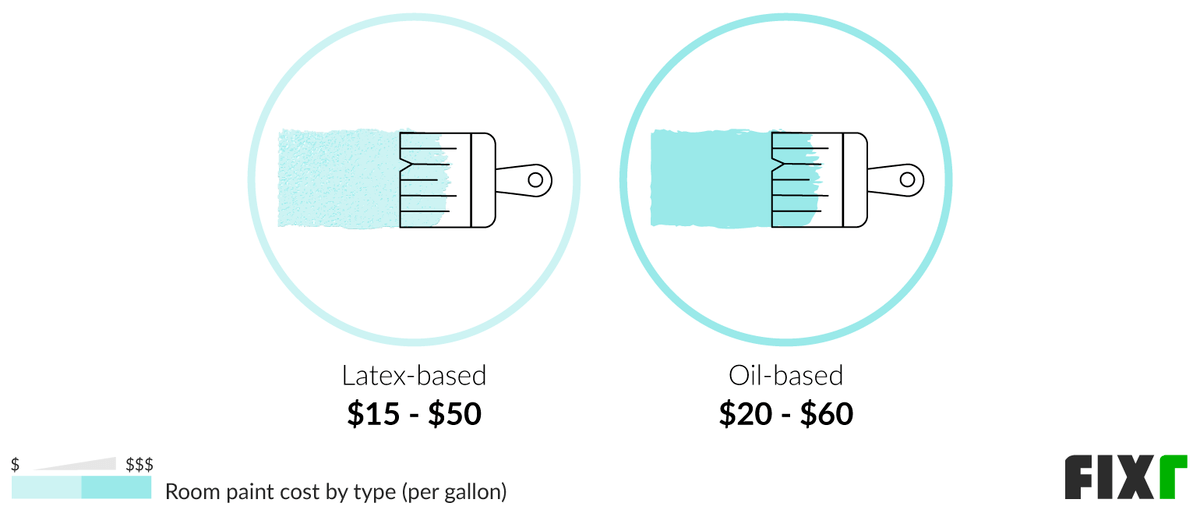
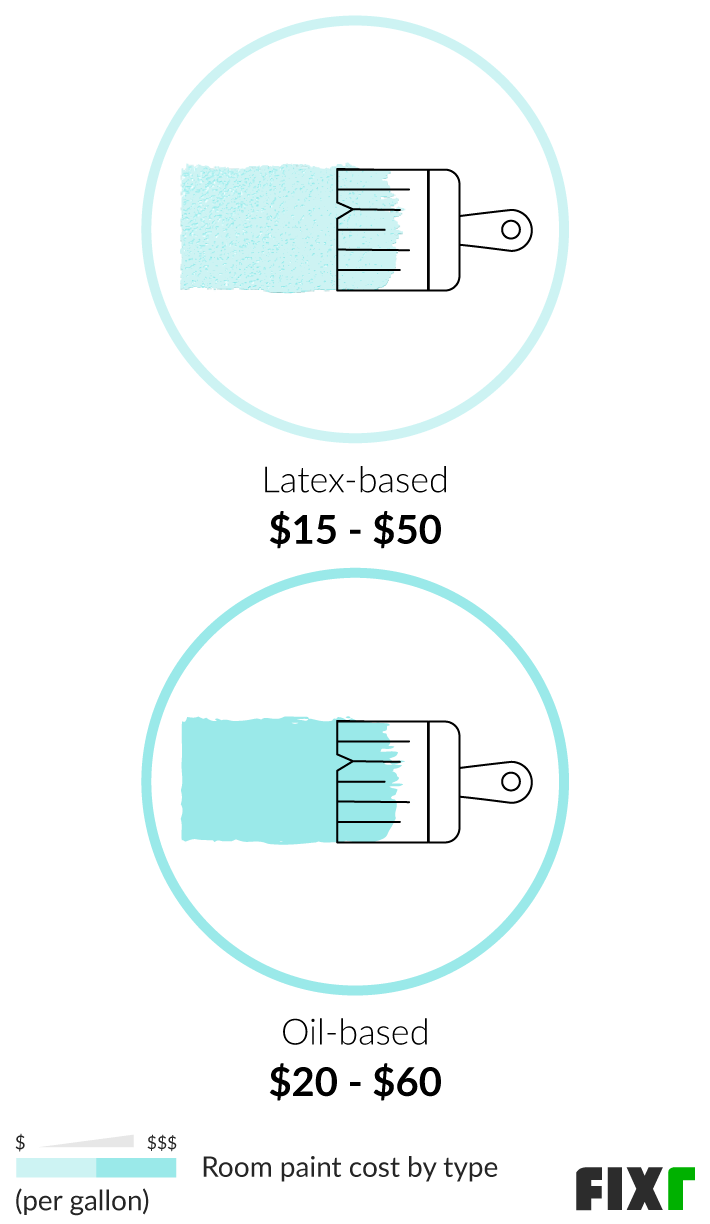
| Type of Paint | Average Cost per Gallon (Material Only) |
| Latex-Based | $15 - $50 |
| Oil-Based | $20 - $60 |
Price to Paint a Room by Type of Finish
The finish you use for your interior paint job impacts the overall look of the room and the longevity of the paint. As a general rule of thumb, higher gloss paints are usually more durable. However, that doesn’t mean they are the best choice for every situation.
Flat finishes are among the most cost-effective and are a great choice for common spaces that don’t see a lot of moisture. It is recommended not to use them in kitchens, bathrooms, or children’s bedrooms. A step up from there are eggshell and satin paint finishes. These are usually a great option for any room in your house because they are durable and low maintenance.
Moving higher up in the gloss levels are semi-gloss and high-gloss paints. These are usually best for accessories and features like trim and baseboards due to their durability and attention-grabbing features.

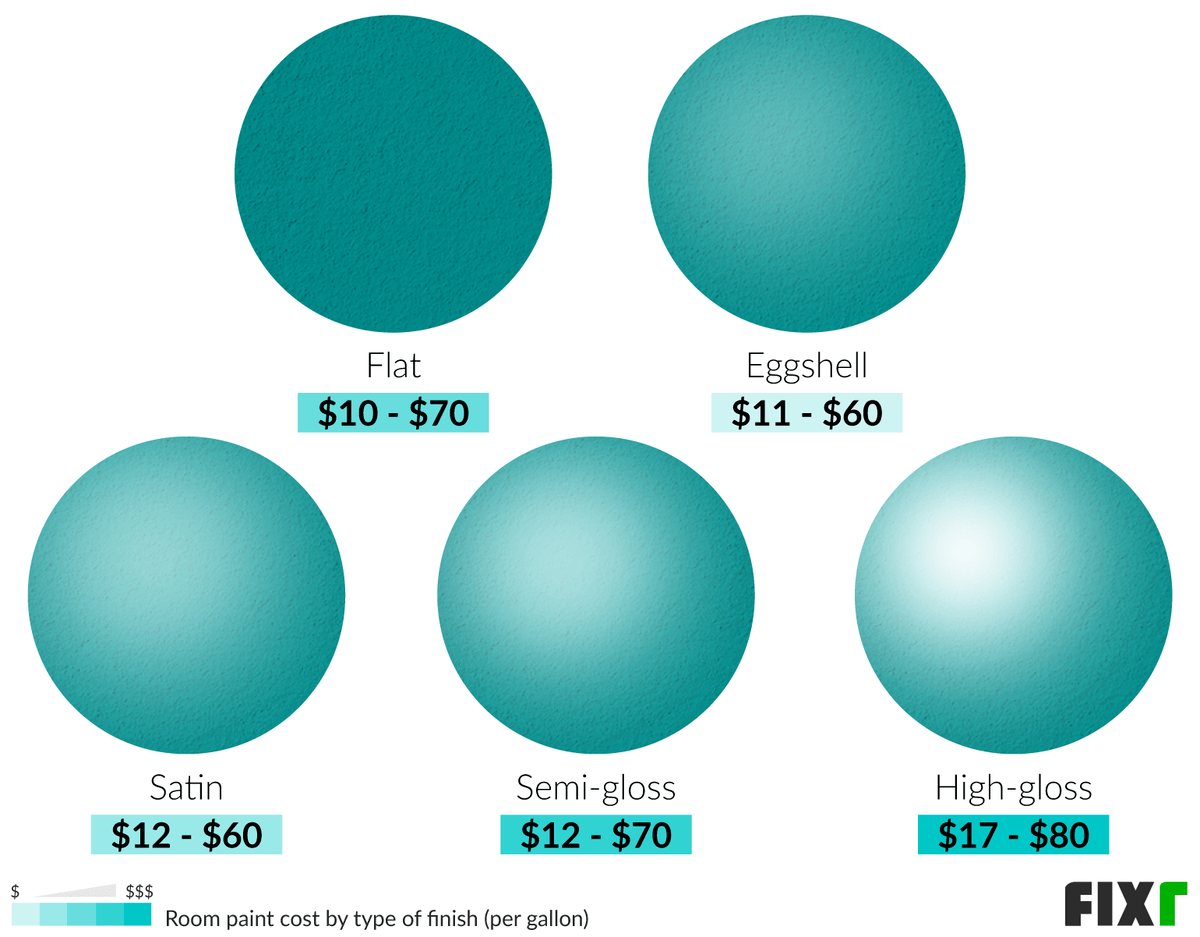
| Type of Finish | Average Cost per Gallon (Material Only) |
| Flat | $10 - $70 |
| Eggshell | $11 - $60 |
| Satin | $12 - $60 |
| Semi-Gloss | $12 - $70 |
| High-Gloss | $17 - $80 |
Average Price to Paint a Room by Type of Primer
Before your painters add the first layer of paint, it’s often a good idea to use a primer. Primers protect the surface and make it easier for the paints to adhere. Oil-based primers can be used with both oil-based and latex-based paints. They are ideal for wood, steel, and other metal surfaces. Latex-based primers are very flexible and fast-drying, making them a great choice for drywall, soft wood, brick, and concrete. Shellac primers are a great choice for wood surfaces. They work well on water- and smoked-damaged walls. Depending on the type of primer you use, you can expect to pay between $16 and $70 per gallon.


| Type of Primer | Average Cost per Gallon (Material Only) |
| Latex-Based | $15 - $60 |
| Oil-Based | $25 - $70 |
| Shellac | $30 - $80 |
Labor Cost to Paint a Room
Hiring a professional is the best way to ensure any painting job gets done the right way. On average, it takes between two to four days to prep, prime, and paint an entire room in your home, depending on the size and layout of the space. The size, shape, and style of your ceiling also play into the cost of your project. Vaulted and cathedral ceilings are a bit more complex and take more time to paint. Along a similar vein, the texture of your walls affects how quickly the painting process goes. Overall costs depend on these factors and where you live and how much your local contractors charge. The price rates to professionally paint a room can be calculated in a few different ways. Generally, painters in the U.S. charge between $25 and $100 per hour or between $1.50 and $3.50 per square foot. If you’re painting baseboards, trim, and more, you can expect to pay $3 to $4 per square foot.
How Much Paint Do I Need to Paint a Room?
When it comes to painting your interior, the first question you’ll probably ask yourself is how much paint you need. To figure this out, it’s important to know the square footage of the room you are planning to paint. As a general rule of thumb, one gallon of paint can cover approximately 400 square feet of space. That means you can expect to use about a gallon of paint to paint the average-sized living room. You’ll need about three gallons to paint a basement. However, other factors affect the amount of paint you need. Usually, darker colors need more than one coat, which adds to your overall cost for materials. Plus, you may want to add a primer coat first. You will need more paint if you’re planning on painting your baseboards, trims, windows, doors, and more.
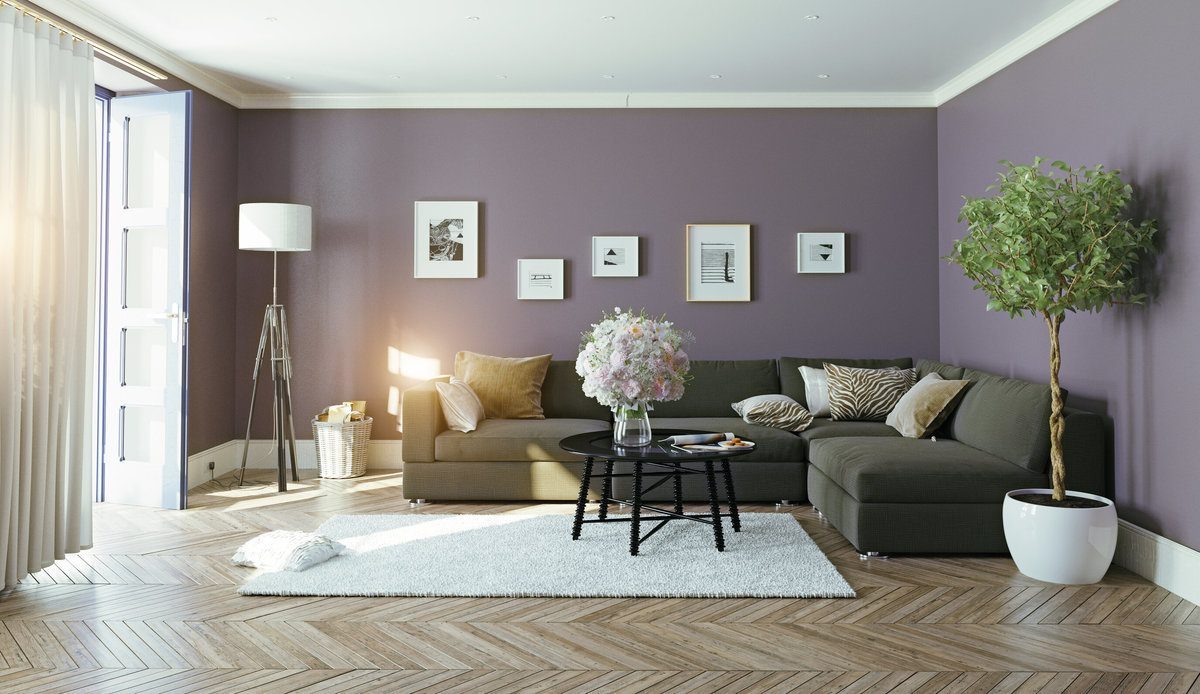
How to Measure a Room for Painting
You can estimate the paint you need for a room in the following way. Consider a standard-sized 12’ x 12’ room with an 8 ft. ceiling, two doors, and two windows. First, measure the perimeter of the room: (12 + 12) x 2 = 48 ft. Calculate the wall area by multiplying the perimeter with the ceiling height: 48 x 8 = 384 sq. ft. Then, calculate the door area (assuming average-sized doors of 21 sq.ft.): 21 x 2 = 42 sq.ft. After that, you’ll need to calculate the window area (assuming average-sized windows of 15 sq.ft.): 15 x 2 = 30 sq.ft. You can calculate the total wall surface by subtracting the door area and window area from the total wall area: 384 - (42 + 30) = 312 sq.ft.
Generally, you use one gallon of good quality paint for 400 sq.ft. (one coat). Ideally, you will need two coats and thereby two gallons of paint for good results.
If you are painting the ceiling, you can calculate the ceiling area by multiplying the width of the room by the length of the room: 12’ x 12’ = 144 sq.ft. This requires around half a gallon of paint.
What to Do Before Painting a Room
Most painting jobs involve a lot of prep work, such as moving furniture out of the room or to the center and covering pieces that cannot be moved with drop cloths. The floor should be covered with large drop cloths or newspaper to avoid paint splatters. The walls should be wiped down to remove all traces of dust and grease. If you skip this step, the paint will not stick properly to the walls, and you may have to redo the painting. Adjacent walls, outlet covers, door knobs, and window trims should be taped off. If there are any holes or cracks in the walls, fill them up with spackling.
Priming is another important part of prep work. Priming seals the wall and provides a good base for the paint. It is especially important if you are painting newly installed drywall, changing the wall color from dark to light, or the earlier paint had a glossy finish. Priming can also cover smoke stains and prevent flashing (shiny spots on the walls) that occurs when the paint is directly applied to spackling.
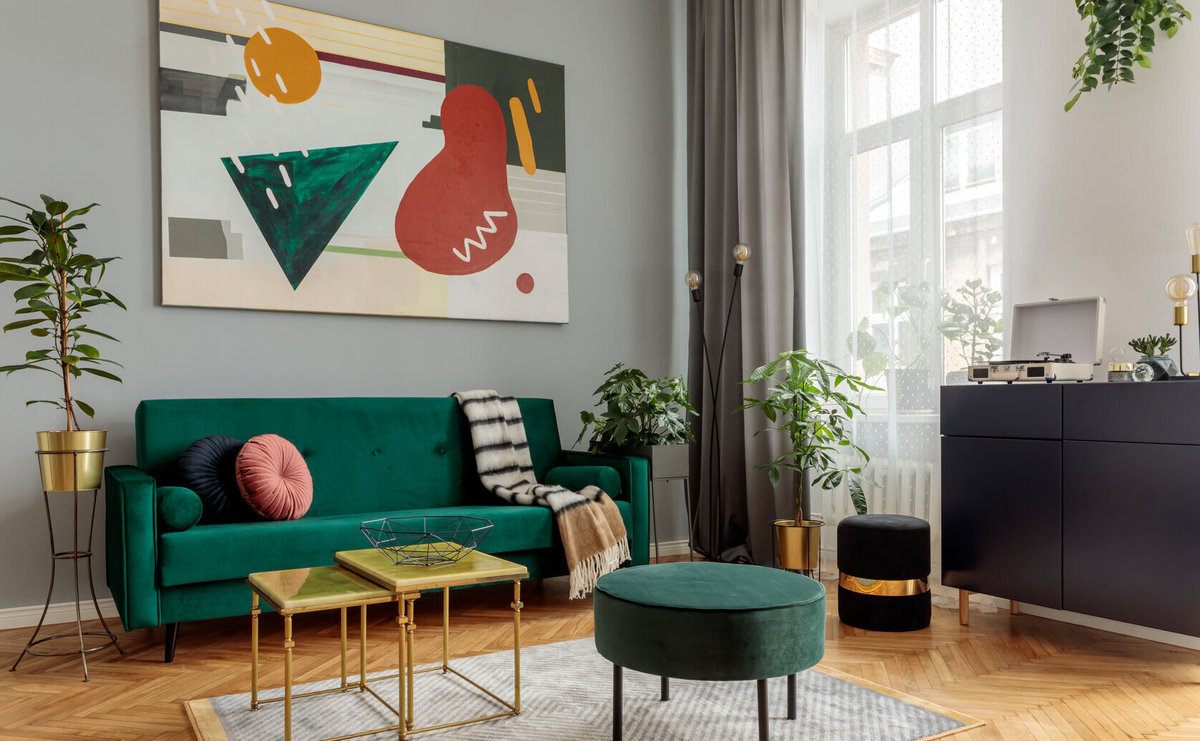
What Color to Paint Your Room?
Paint colors can have a huge effect on your moods, emotions, and well-being of those who use that space. Hence, it is very important to choose the right paint color for a room. When shopping for paint, do not pick up any color that looks good or is the latest design trend. Instead, consider the mood you want to set in your room and how the color makes you feel. Generally, warm and cozy colors impart joy and upliftment, while cool and soothing colors like deep blues lend a formal, dignified appearance.
Your perception of color may be influenced by your personality or culture. Some colors are timeless and perfect, adding to a room no matter the current date. Others may be popular for a few years and then look dated.
According to the latest report on paint trends, light and neutral colors are often an excellent option for living rooms. Consider hues like sage green, cream, cool off-white, and taupe to appeal to the largest group. When it comes to bedrooms, a touch more color is often appreciated with hues like navy, khaki green, and lilac, in addition to many of the colors that work best in a living room.If you are finding it difficult to figure out which colors work well together, use the color wheel to find complementary colors (located opposite on the wheel), split complementary colors (colors on each side of the complementary color on the wheel), and related colors (located next to each other on the wheel).
You can choose to have your room painted with a solid coat of color or use decorative painting techniques like color washing, crackle, and ombre for a unique appearance.
Add-Ons to Your Room Painting Project
Plenty of factors play a part in the overall cost to have a room painted, so it’s important to fully plan out your project before you call your local painting contractors. This includes additional spaces that need to be painted, preparations, paint removal, repairs, and post-painting cleanup. Let’s dive into each of these a bit more.
If you’re planning on painting your ceiling, it’s important to have the space fully ready to go. That means cleaning and looking for damage and clearing any furniture or other items out of the room. The ceiling material plays a big part in the overall cost of your project as some are easier to paint than others.
When painting anything in your home’s interior, it’s important to move any furniture and important belongings out of the way. First and foremost, this ensures they don’t get damaged. It drastically helps out your painting team and reduces the overall time of your paint job. Painting your trim and baseboards adds to the overall cost of the job because it is a more delicate job that requires special care. Your painting contractors have to tape off any areas to ensure paint doesn’t spill over and use a careful technique depending on the style of your trim. This also goes for painting your windows and doorways.
If you need to remove wallpaper or old paint before starting the paint job, it’s important to factor this into the final cost. This job should be left to a professional to ensure it is done correctly. That way, you’ll also know the new paint will last longer on a well-prepped surface.
Another important consideration is if your walls or ceiling are not in peak condition. Wall repairs should be completed before any painting is done to preserve the paint job. This includes patching holes, sanding, and more. Finally, you need to think about what happens after your painters are done. Cleanup costs are generally included in the entire price of the paint job, but there are things you can do to help your contractors. That includes keeping your space clean throughout the process and getting rid of any clutter.


| Add-Ons | Average Cost (Labor Included) |
| Painting Your Ceiling | $0.50 - $3 (per sq.ft.) |
| Moving Furniture | $50 - $70 (per room) |
| Painting Trim and Baseboards | $1 - $4 (per sq.ft.) |
| Painting Windows | $35 - $50 (per window) |
| Painting Doors | $35 - $50 (per door) |
| Wall Repairs | $75 - $350 (per room) |
| Wallpaper Removal | $0.75 - $4 (per sq.ft.) |
| Paint Removal | $4 - $9 (per sq.ft.) |
| Sanding and Patching | $50 - $115 (per room) |
| Cleanup | $20 - $50 (per room) |
Additional Considerations and Costs
- DIY. While you can paint your interior yourself, it is always better to leave it to a professional. If you decide to tackle the project on your own, be sure to choose the right paints, properly measure your space, and block off any sections that could get ruined in the process.
- Value of home. Painting your home’s interior is a great way to add value to your property. This can be especially useful if you are planning on selling. If that is the case, be sure to use neutral colors that open up the space and make it feel brand-new.
- Time of year. The price to paint a room varies based on the time of year it is done. In many cases, it will cost the least when scheduled for fall or winter months. Many painting companies have fewer clients from November through February since fewer people want exterior painting done when it is cold out. This makes prices competitive for interior painting, too.
FAQs
- How long does it take to paint a room?
On average, it takes between two to four days to paint an average-sized room. This includes prep time, priming, and painting. Usually, your team consists of one to three painters, making the process go by more quickly but could end up costing more in terms of labor costs.
- What colors make a room look bigger?
If you want to make a smaller room appear larger, your best bet is to use lighter colors. Brighter walls are more reflective, which opens up a space dramatically. It also makes the most of the natural lighting that filters into your space. Another tip is to paint trim and moldings an even lighter color to make them appear further away.
- Which color is best for the bedroom?
While you may lean toward cool neutral colors in your day-to-day life, hues like navy, khaki green, and lilac are actually the better option for your bedroom. Also, choosing earthy tones and neutrals with pops of bold colors is a great way to revitalize your bedroom.
- What room colors affect your mood?
Warm colors or colors in the red area of the color spectrum, for example, red, yellow, and orange, are associated with a wide range of emotions that range from warmth and comfort to anger and hostility. Cool colors or colors in the blue area of the spectrum, for example, blue, green, and purple, evoke feelings of calmness, sadness, or indifference.
- How much does a painter charge per room?
Most painters charge by the hour for interior painting projects. You can expect to pay around $50 per hour, depending on your location and the level of experience of the painter.
- How much does it cost to paint a 12' x 12' room?
On average, the cost to paint only the walls of a 12 x 12 foot room is $215 to $505 or $430 to $575 if you have trim, baseboard, and ceiling painted. This varies based on the brand of paint, type of paint, and how many coats of paint are needed. The location also play a part in the labor cost if a professional handles the painting process.
- How much does a painter charge per square foot?
Painters usually charge by the hour ($50 per hour) for interior painting jobs. Some projects may be charged at a flat rate calculated based on the square footage. A basic painting job may cost around $1.50 to $3 per sq.ft., labor and materials included. Textured walls and decorative finishes are usually more expensive at $2 to $4 per sq.ft.
